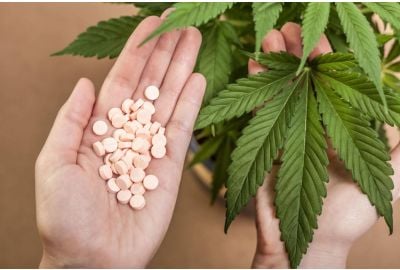Does Weed Interact With Any Medications?
Does weed interact with medications?
Given the meteoric rise of cannabis as an alternative medicament over the three decades, it's not uncommon for people to wonder about drug interactions with marijuana.
Due to the complex physicochemical processes within the human body, just about everything from illicit drugs (including cannabis) to prescription meds interact with one another.
Even though medical cannabis is a natural medicament and generally safe to use, users must take caution when using marijuana mixed with other drugs as it may result in adverse reactions.
Cannabis drug interactions happen due to weed having the potential to:
- Interact with conventional medication
- Alter how pharmaceuticals are metabolized in the human body
Understanding marijuana drug interactions and knowing which pharmaceuticals you shouldn't use in conjunction with cannabis significantly reduces the risk of unwanted adverse reactions.
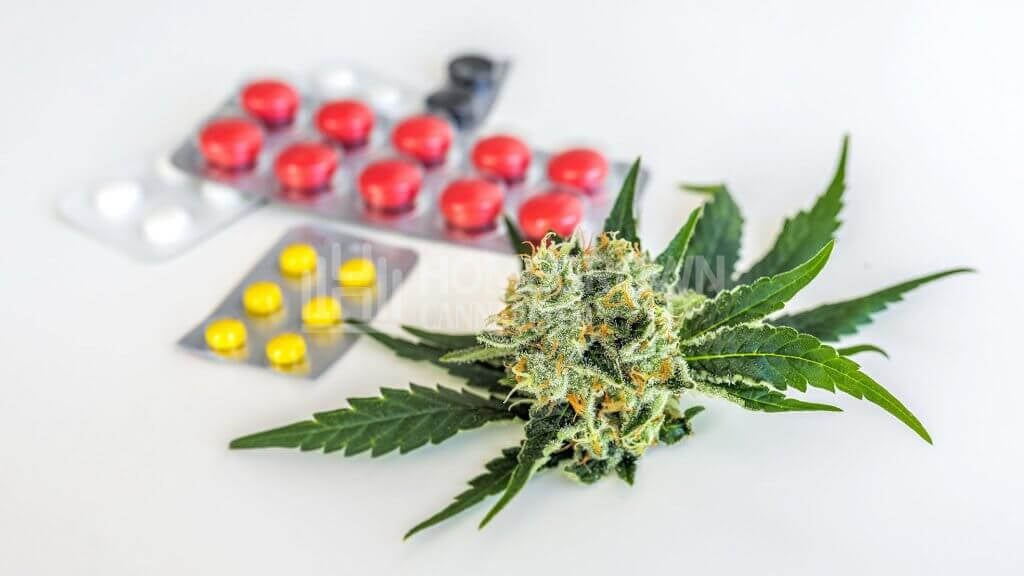
The dangers of cannabis drug interactions
Before we delve into the dangers of cannabis drug interactions, you need to understand how the synergistic, additive, and antagonistic effects differ from one another:
- Additive effect (double up) means that the resulting interaction of two chemicals equals the sum of their parts, for instance, 1+1=2.
- Synergistic effect (increase) implies that when two drugs interact, the one boosts the other, making the outcome more than the sum of their parts, for instance, 1+1=3.
- Antagonistic effect (reduce) suggests that when two medications interact, the one decreases the efficiency of the other, resulting in a value less than the sum of their parts, for instance, 2+2=3.
Smoking weed while on medication may create adverse reactions.
The impact of marijuana drug interactions can increase, reduce, or double up the efficiency of the meds, resulting in life-threatening and unpredictable consequences.
Synergistic or additive effects can be extremely dangerous if the pharmacodynamic impact gets increased too far beyond the intended threshold of the drugs.
Similarly, due to the interacting substances being metabolized (processed) by the same receptors within the body, antagonistic effects can cause severe problems.
Marijuana and other drugs used in conjunction may also result in chemical reactions, potentially producing dangerous byproducts during the metabolic process.
Other severe clinical ramifications of cannabis drug interactions include:
- Increased healthcare costs
- Reduced medication adherence
- Altered drug response
If taking multiple drugs is inevitable, it's crucial to familiarize yourself with:
- All possible interactions between marijuana and medication
- How long the chemicals stay in your system
Having this knowledge enables you to consume both drugs but at different times, ensuring the drugs' effects won't overlap, thereby minimizing the risk of adverse effects.
Cannabis and the CYP450 pathway
Even though medical evidence suggests that CBD is generally fairly safe, non-addictive, and well-tolerated, synergistic drug interactions with cannabis can occur in some patients.
How does weed interact with medications?
Cytochrome P450 (CYP450) isn't a drug. It's an elaborate collection of essential enzymes based in the liver, responsible for metabolizing any drugs that enter your system. It effectively breaks down all drugs for elimination and, when necessary, activates the "prodrug" effect.
The "prodrug" effect refers to converting pharmaceutical drugs into active metabolites, allowing them to exert all or most of their pharmacologic impact.
If the CYP450 pathway doesn't activate prodrugs, they'll remain inactive, failing to provide their intended effect. Without CYP450 enzymes, ingested drugs will remain in the body, making the patient significantly more prone to adverse effects.
Any alteration or blockage of the CYP450 pathway can considerably impact the uptake of a broad range of substances.
Due to CBD's potential to suppress CYP2D6 and CYP450 enzymes, patients must avoid using cannabis in conjunction with most prescription pharmaceuticals.
CBD may decrease or increase the liver's drug metabolization rate, reducing the medication's overall efficiency and enhancing the risk for marijuana drug interactions.
Likewise, CYP3A4 inhibitors increase the THC concentration in the bloodstream, leading to prolonged elimination from the system and potential unpleasant effects.
THC also acts as a CYP1A2 inducer, which may cause THC drug interactions resulting in decreasing the serum concentrations of prescription medications such as:
- Chlorpromazine
- Olanzapine
- Haloperidol
- Naproxen
- Cyclobenzaprine
- Clozapine
- Duloxetine
CYP450 metabolized prescription medications that may cause drug interactions with marijuana include:
- Oral hypoglycemic agents
- Sulfonylureas
- NSAIDs
- Angiotensin II blockers
- Beta-blockers
- PPIs
- Antidepressants
- Anti-epileptics
- Anesthetics
- Antipsychotics
- Antiarrhythmics
- Antibiotics
- Immune modulators
- Benzodiazepines
- Prokinetics
- HIV antivirals
- Calcium channel blockers
- Antihistamines
- Steroids
- HMG CoA reductase inhibitors

Weed and medication: Do the various cannabinoids interact differently with prescription drugs?
Overall, cannabis is well-tolerated, relatively safe, and has fewer risks of unpleasant drug interactions than most prescription drugs.
However, cannabis isn't a single drug. Instead, it's a complex plant that contains various cannabinoids, terpenes, and other compounds.
Influenced by these compounds, the potential for various cannabis drug interactions is fairly high. That said, patients should also note that THC and CBD interact differently with prescription drugs, meaning that marijuana can cause various drug interactions simultaneously.
Cannabidiol drug interactions
CBD is known to inhibit CYP2D6 and CYP3A4 enzymes within the CYP450 pathway.
The obstruction of these enzymes may cause cannabidiol drug interactions, reducing or enhancing the rate at which the liver metabolizes pharmaceuticals.
These interactions also decrease the overall efficiency of the meds and liver.
THC drug interactions
THC drug interactions are slightly more complicated.
The combination of CYP3A4 inhibitors and THC slightly boosts THC levels in the bloodstream, leading to adverse effects and the prolonged elimination of THC from the body.
Due to THC being a CYP1A2 inducer, further THC drug interactions are also possible as it can decrease the serum concentrations of prescription drugs such as:
- Chlorpromazine
- Haloperidol
- Olanzapine
- Cyclobenzaprine
- Naproxen
- Duloxetine
- Clozapine
10 possible pharmacodynamic marijuana drug interactions
At present, there are a total of 612 known cannabis drug interactions:
- 483 are moderate
- 129 are major
Major marijuana drug interactions are clinically highly significant, making it crucial to avoid these combinations at all costs as the disadvantages severely outweigh the benefits.
Even though it's also wise to avoid moderate drug interactions with cannabis, the cons are less severe, and, under special circumstances, patients can use them in conjunction if necessary.
Disclaimer: The information provided in this article is for educational purposes only and should not be viewed as medical advice. It doesn't replace expert recommendations and diagnoses from medical professionals and may not be a complete list of potential weed and medication interactions.
Always consult with a licensed physician before using marijuana and prescription drugs in conjunction.
1. Benzonatate
Benzonatate (antitussive medications) are used to alleviate or prevent coughs associated with ailments such as:
- The common cold
- Flu
- Asthma
- Emphysema
- Bronchitis
- Pneumonia
These drugs suppress the cough reflex in the air passages and lungs. The most common brands of this medication include:
- Zonatuss®
- Tessalon Perles®
- Tessalon®
Using benzonatate and marijuana together may cause moderate drug interactions, resulting in unwanted side effects such as:
- Intense dizziness
- Purging
- Dyspnoea (labored or difficult breathing)
- Urinary retention (inability to partially or completely empty the bladder)
- Drug abuse
- Pneumothorax (Gas or air trapped in the cavity between the chest wall and lungs, potentially resulting in lung collapse)
- Bladder dilatation
Physicians generally don't recommend using benzonatate and marijuana in conjunction.
Benzonatate lingers in the system for up to eight hours after consumption, making it wise to avoid using cannabis during this time frame.
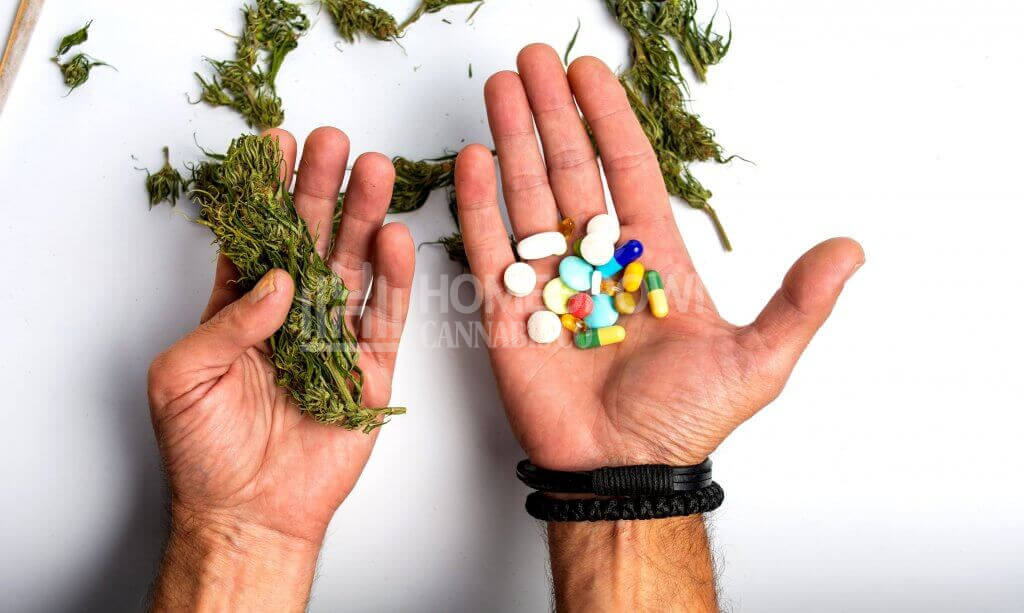
2. Antidepressants
Antidepressants reduce the effects of depressive disorders by stabilizing chemical imbalances within the brain, resulting in improved behavior and mood.
Depression patients lack the following primary neurotransmitters:
- Norepinephrine
- Dopamine
- Serotonin
SNRIs and SSRIs inhibit the reuptake of specific neurotransmitters, increasing their levels around the receptors and synapses of the brain.
SNRIs (selective and norepinephrine reuptake inhibitors) brands include:
- Desvenlafaxine (Pristiq®)
- Venlafaxine (Effexor®)
- Duloxetine (Cymbalta®)
SSRIs (selective serotonin reuptake inhibitors) brands include:
- Sertraline (Zoloft ®)
- Paroxetine (Paxil®)
- Fluvoxamine (Luvox®)
- Fluoxetine (Prozac® and Sarafem®)
- Escitalopram (Lexapro®)
- Citalopram (Celexa®)
Due to their severe side effects, MAOIs and TCAs fell out of favor and are seldom prescribed, yet, they can also cause drug interactions with marijuana.
Popular TCAs (tricyclic antidepressants) and MAOIs (monoamine oxidase inhibitors) include:
- Trimipramine (Surmontil®)
- Doxepin (Sinequan ® and Adapin®)
- Amitriptyline (Elavil®)
- Imipramine (Tofranil®)
- Isocarboxazid (Marplan®)
- Phenelzine (Nardil®)
- Tranylcypromine (Parnate®)
Even though mixing weed and SNRIs/SSRIs only cause mild to moderate cannabis drug interactions, research shows that SSRIs obstruct CYP450 system enzymes.
For this reason, these agents can cause severe central nervous system depression. They can also potentially impair the metabolism of a broad spectrum of pharmaceuticals.
Due to their high-risk profile and capacity for inducing adverse effects, marijuana drug interactions with TCAs and MAOIs tend to be more severe.
Some of the most common side effects related to cannabis drug interactions are:
- Mood swings
- Severe headache
- Gastrointestinal distress
- Agitation and anxiety
- Excessive paranoia
- Thought, judgment, and motor coordination impairment
- Insomnia
- Confusion
- Difficulty concentrating
- Intensified drowsiness and dizziness
- Hypomania (Excited, nervous, jittery, and irritable state)
Since marijuana drug interactions with SNRIs/SSRIs create a synergistic effect, increasing the brain's serotonin levels, the excessive stimulation may result in Serotonin Syndrome.
The symptoms of this condition are:
- Shivering and goosebumps
- Twitching muscles
- Impaired muscle coordination
- Heavy sweating
- Rapid heart rate
- Tremors
- Nausea
- Vomiting
- Diarrhea
- Headache
- Hypertension
- Dilated pupils
- Confusion
- Agitation or restlessness
- Arrhythmias
- Seizures
- High fever
- Unconsciousness
If you experience some or all of these symptoms, it's crucial to seek immediate medical attention, as this drug interaction with cannabis may be life-threatening.
3. Anticonvulsants
Does weed interact with medication for epilepsy?
Anticonvulsants, aka anti-epileptics, are used to treat neuropathic pain, epileptic seizures, and as a mood stabilizer in bipolar patients.
Through the modulation of various neurotransmitters, these drugs suppress the rapid and excessive firing of neurons during epileptic seizures within the brain.
They also help prevent the continuous spreading of these attacks.
Conventional anti-epileptics enhances gamma-aminobutyric acid (GABA – An amino acid that acts as an inhibitory neurotransmitter in the brain and spinal cord).
New generation anti-epileptic drugs reduce the release of excitatory glutamate, which, in high levels, are typically associated with a patient's susceptibility to experience seizures.
Some of the most frequently prescribed anticonvulsants are:
- Vigabatrin (Sabril®)
- Valproate (Convulex®, Stavzor®, Epilim®, Depakote®)
- Perampanel (Fycompa®)
- Rufinamide (Banzel®)
- Gabapentin (Neurontin®)
- Brivaracetam (Briviact®)
- Ezogabine (Potiga®)
- Lacosamide (Vimpat®)
- Clobazam (Onfi®)
- Topiramate (Topamax®)
- Zonisamide (Zonegran®)
- Eslicarbazepine (Aptiom®)
Cannabidiol drug interactions may occur when a patient uses CBD in conjunction with N‐Desmethylclobazam, topiramate, and rufinamide, increasing the drug's serum levels.
Cannabis drug interactions with clobazam have the exact opposite effect, with heavy sedation thrown into the mix. The change in drug levels remains well within the acceptable range, though.
Valproate also causes drug interactions with cannabis, exhibiting higher ratios of AST and ALT, acting as an indication of abnormal liver function.
Therefore, patients must take caution when using Valproate in conjunction with CBD as it may result in liver problems.

4. Benzodiazepines
Does anti-anxiety medication cause drug interactions with cannabis?
Doctor's most commonly prescribed CNS depressants, aka Benzodiazepines, to patients dealing with:
- Anxiety disorders
- Insomnia
- Seizures
- Panic attacks
These drugs induce intense sedation and relaxation by increasing the effects of GABA, resulting in a reduction of nerve activity within the brain.
Major FDA approved benzodiazepine brands include:
- Flurazepam (Dalmane®)
- Quazepam (Doral®)
- Diazepam (Valium®)
- Clorazepate (Tranxene®)
- Temazepam (Restoril®)
- Chlordiazepoxide (Librium®)
- Oxazepam (Serax®)
- Lorazepam (Ativan®)
- Alprazolam (Xanax®)
- Clonazepam (Klonopin®)
- Midazolam (Versed®)
Cannabis, especially high CBD strains, can potentially enhance the sedative effect induced by benzodiazepines.
For this reason, patients must avoid using benzodiazepines in conjunction with marijuana at all costs, as these combinations can cause severe THC drug interactions.
THC drug interactions, resulting in increased anxiety, are possible as well.
Due to obstructing the CYP450 system, other potential cannabis drug interactions, such as benzodiazepine build-up in the system, may also occur.
Symptoms related to benzodiazepine drug interactions with marijuana include:
- Slurred speech
- Constipation
- Impairment in judgment and thinking
- Impaired motor skills
- Unresponsiveness
- Confusion
- Lack of concentration
- Increased risk of breathing problems
- Profound sedation, sleepiness, and drowsiness
- May induce a coma
5. Antipsychotic medication
Do antipsychotic drugs interact with marijuana?
Antipsychotic medications are psychiatric drugs used in the treatment of various psychotic and mood disorders such as:
- Severe depression
- Bipolar disorder
- Schizoaffective disorder
- Schizophrenia
By blocking the effect of dopamine, these drugs efficiently decrease psychotic symptoms like:
- Paranoia
- Disruptive behavior
- Hallucinations
- Delusions
There are two classes of antipsychotics:
- Typical
- Atypical
Even though there's no significant difference between the two classes, research revealed that atypical antipsychotic drugs are easier to use.
Commonly prescribed typical antipsychotics include:
- Trifluoperazine (Stelazine®)
- Sulpiride (Dolmatil®)
- Haloperidol (Haldol®)
- Pimozide (Orap®)
- Chlorpromazine (Largactil® and Thorazine®)
Popular atypical antipsychotics are:
- Olanzapine (Zyprexa®)
- Risperidone (Risperdal®)
- Clozapine (Clozaril®)
- Quetiapine (Seroquel®)
- Amisulpride (Solian®)
- Aripiprazole (Abilify®)
Using a combination of weed and any of the listed antipsychotic drugs is ill-advised as these meds already come with a wide range of side effects.
Even though research related to cannabis drug interactions with antipsychotics is lacking, combining the two may result in severe and unpredictable adverse consequences.
Due to most marijuana strains and antipsychotic drugs being heavy tranquilizers, the combined tranquilizing effect may become too much for patients to handle.
Drug interactions between cannabis and Seroquel or Abilify may also occur, heightening the impact of these pharmaceuticals.
Potential symptoms related to cannabis drug interactions with antipsychotics include:
- Confusion
- Impaired driving
- Slow motor skills
- Excessive sedation
- Decreased cognitive function
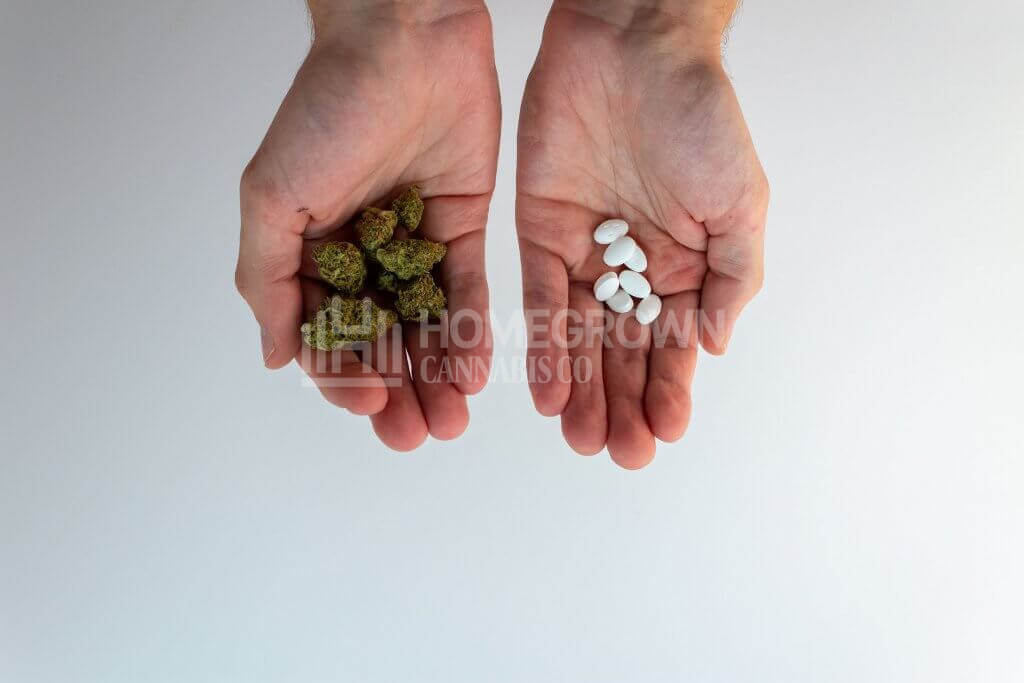
6. Opioid painkillers
Opioids are narcotic painkillers used for treating severe pain.
After binding to the opioid receptors in the spinal cord, brain, and other human body areas, these drugs block the pain pathways to stimulate pain reception.
Unfortunately, the prolonged use of opioids in large doses comes with the risk of severe side effects, reducing their appeal as a form of treatment.
Drug interactions with other pharmaceuticals can also induce adverse effects like:
- Respiratory failure
- Coma
- Overdose
- Death
The discovery of marijuana's potent analgesic effects brought to light the potential for lessening opioid prescriptions.
Low doses of either opioids or weed on their own don't relieve pain.
With both cannabis and these drugs interacting with the CB1 receptors, using lower doses of each brings immense pain relief to patients while reducing the side effects of opioids.
It must be noted, though, that marijuana drug interactions may occur when co-administered with certain opioids.
7. Propoxyphene
Does weed interact with medication for pain relief?
Propoxyphene is a group of narcotic painkillers used to alleviate mild to moderate pain.
Pharmaceuticals containing propoxyphene are known to cause severe drug interactions with cannabis, increasing adverse effects such as:
- Difficulty concentrating
- Confusion
- Drowsiness
- Dizziness
- Oversedation
For this reason, it's crucial to avoid using cannabis in conjunction with the following propoxyphene-containing drugs:
- Propoxyphene® Compound 65
- Trycet®
- PP-Cap®
- Propacet® 100
- PC-Cap®
- Wygesic®
- Darvon® (Compound 32, Compound 65, N)
- Balacet®
- Darvocet® (N 100, A500, N 50)
8. Buprenorphine
Painkillers containing buprenorphine are extremely high-risk treatment options as they exhibit severe adverse reactions such as:
- Coma
- Respiratory distress
- Death
Marijuana drug interactions with buprenorphine may further heighten these side effects due to both substances depressing the central nervous system.
The combined use of weed and buprenorphine can cause the following side effects:
- Arrhythmia and bradycardia
- Reduced cognitive abilities
- Impairment in motor function
- Slurred speech
- Inability to stay awake
- Heavy sedation
- Breathing difficulties
To avoid these adverse effects, patients should under no circumstances use cannabis in conjunction with the following brands:
- Suboxone®
- Subutex®
- Zubsolv®
- Bunavail®
- Buprenex®
- Probuphine®
- Butrans®
- Belbuca®
9. Levomethadyl acetate hydrochloride
Levomethadyl Acetate Hydrochloride, aka Orlaam®, is a synthetic opioid painkiller known for its potentially life-threatening proarrhythmic effects.
Orlaam will only ever be used as a last resort in patients who fail to show significant improvement from other treatments.
The drug has potent heart rate increasing and sedative effects, making the use of this pharmaceutical in conjunction with cannabis ill-advised.
Drug interactions with marijuana and Orlaam can boost these effects, leading to adverse reactions such as:
- Impaired thinking
- Impaired judgment
- Arrhythmia or torsades de pointes
- Poor motor coordination
- Confusion
- Depression
- Oversedation
- Syncope or fainting
10. Alcohol
While it isn't a pharmaceutical, alcohol and cannabis are the two most frequently used substances in America.
Although "crossfading" (the combined use of alcohol and cannabis) is quite popular, it can pose significant risks.
Marijuana drug interactions with alcohol are quite common. Using these substances in conjunction exaggerates the effects of each drug.
Increased THC levels can cause:
- Terrifying panic attacks
- Extreme paranoia
- Disorienting short-term memory loss
- Frightening hallucinations
- Complete disconnection from reality
Exaggerated alcohol effects can lead to various unpleasant consequences, including:
- Vomiting
- Nausea
- Slurred speech
- Complete loss of motor skills
- Blurred vision
Combining alcohol and cannabis creates a recipe for disaster.
Cannabis drug interactions with alcohol significantly increase the user's risk for alcohol poisoning as weed prevents you from vomiting, which helps to flush booze out of your system.
It also decreases your ability to operate heavy machinery or drive a vehicle considerably, making it crucial to stay far away from these activities if you've combined these two substances.

9 tips to avoid harmful drug interactions with marijuana
Familiarizing yourself with the potentially detrimental effects of drug interactions with marijuana and which pharmaceuticals may cause them is the key to avoiding these adverse impacts.
Precautionary steps to eliminate your risk of marijuana drug interactions.
- Always read the leaflet inside the packaging and consumption guidelines carefully, making sure you understand all pertinent information, such as the drug interaction precautions and contraindications.
- Consult with your physician if marijuana drug interactions are identified to draw up a consumption schedule, allowing you to take the drugs at different times.
- Always keep prescription meds in their original packaging, making them easily identifiable if necessary.
- If your physician prescribes new meds, it's your priority to ask your doctor which drugs, dietary supplements, beverages, and food you need to avoid to eliminate potential complications.
- Get professional advice from your physician or pharmacist before using any over-the-counter (OTC) medication in conjunction with previously prescribed meds.
- Make a point of purchasing all your medication from one pharmacy only. Doing this grants the pharmacist the opportunity to keep a record of all your prescribed medication and the ability to provide you with solid advice about potential side effects and drug interactions with marijuana.
- Keep a list of all your OTC drugs, prescription meds, and dietary supplements that you're consuming at present and take it with you every time you've got a medical appointment.
- Always inform your physician and other health care providers about all the drugs you're currently taking to minimize your risk of cannabis drug interactions with newly prescribed meds.
- Avoid taking illicit drugs in conjunction with prescription meds. If it does happen, though:
- Use only one drug type at a time.
- Be sure to tell a friend who can phone 911 in case of emergency and inform the responders on which drugs you've taken.
- Get information from credible sources on what to do during an overdose or crisis.
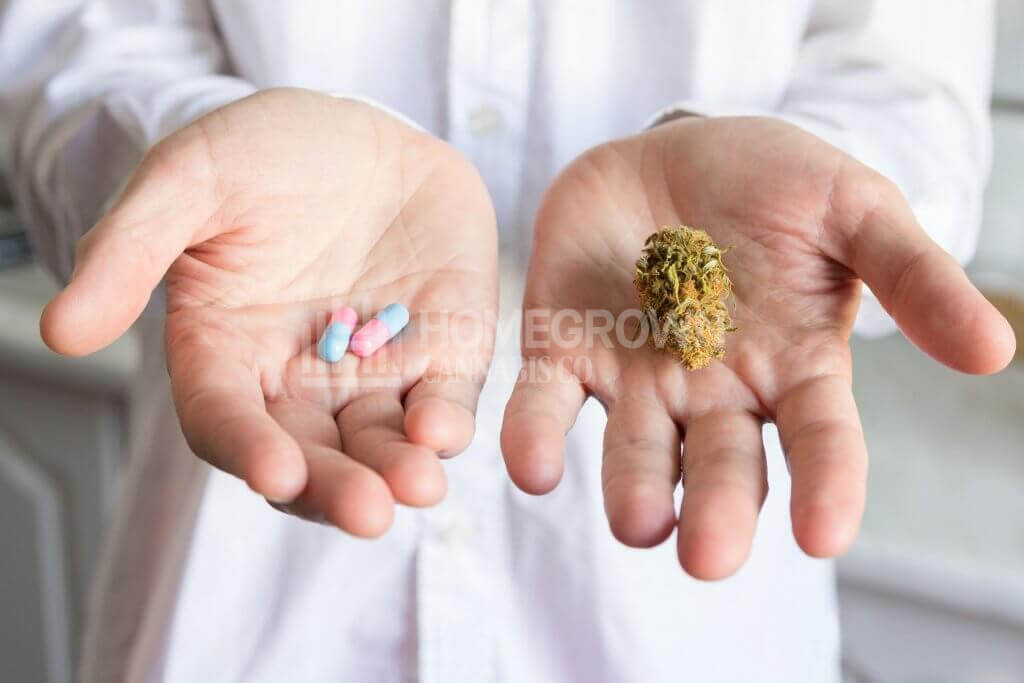
Stay safe: Familiarize yourself with marijuana drug interactions
Does weed interact with any medications?
Cannabis is held in high regard worldwide for its broad spectrum of potential therapeutic benefits.
Marijuana's therapeutic versatility gives it the potential to reduce the necessity to combine various meds with a high risk of producing adverse reactions.
Using weed in conjunction with prescription meds to enhance its effects may backfire due to cannabis drug interactions, resulting in moderate to severe adverse reactions.
Taking marijuana and prescription drugs together can produce synergistic or antagonistic effects, potentially negatively impacting biological processes.
For this reason, you should never combine weed with conventional meds without first consulting with your physician.
Stay safe: Avoid potentially severe consequences by familiarizing yourself with all possible marijuana drug interactions.
Are you looking to replace most of your prescription medication with a natural alternative that works?
Homegrown Cannabis Co. offers a wide range of well-priced medical marijuana and high CBD strains, ready to be shipped to you discreetly and at a moment's notice.
Log on to Homegrown Cannabis Co.'s website and order your first batch of medical marijuana seeds today.
